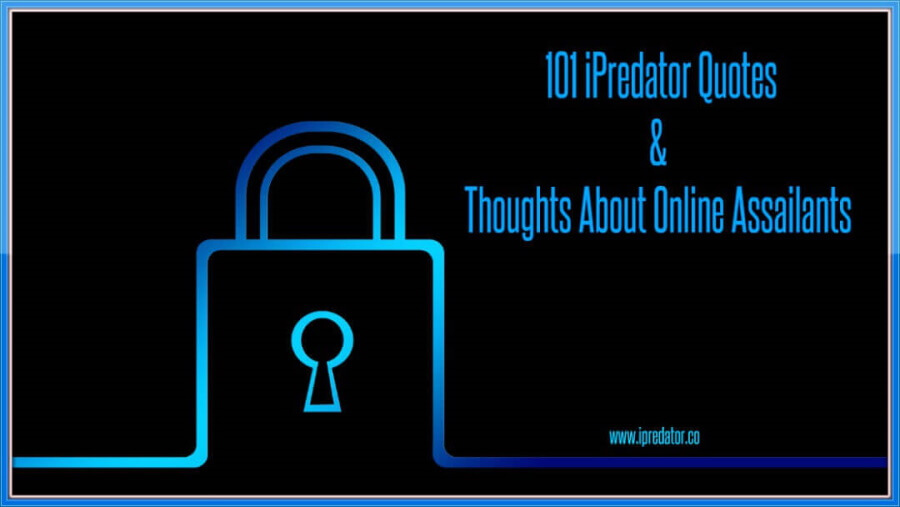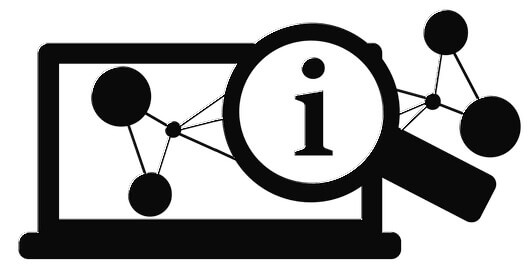101 iPredator Quotes
&
Thoughts About Online Assailants

Provided here are 101 iPredator themed quotes, internet safety tips and cyber-attack prevention concepts created by Michael Nuccitelli, Psy.D. The goal is to foster discussions on learning to profile and identify online users who participate in nefarious and malevolent activities.
As Information and Communications Technology (ICT) becomes more widespread; cyber-attack prevention, online safety education and digital citizenship are areas requiring immediate attention. The Information Age has many benefits, but it is vital to identify and prevent the malevolent and nefarious elements that exist in cyberspace. Dr. Nuccitelli’s iPredator concept definition & his quotes and thoughts about online assailants are as followed:
(PDF Paper Download Button)
iPredator
iPredator: a person, group, or nation who, directly or indirectly, engages in exploitation, victimization, coercion, stalking, theft, or disparagement of others using Information and Communications Technology (ICT). iPredators are driven by deviant fantasies, desires for power, control, and retribution, religious fanaticism, political reprisal, psychiatric illness, perceptual distortions, peer acceptance, or personal and financial gain. iPredators can be any age or gender and are not bound by economic status, race, religion, or national heritage. Their sole requirement to get started in this dark dimension is an internet connection.
Central to the concept is the premise that information age criminals, deviants, and the violently disturbed are psychopathological classifications new to humanity. Whether the offender is a cyberbully, cyberstalker, cyber harasser, cybercriminal, online sexual predator, cyber terrorist, internet troll, online child pornography consumer/distributor, or a person engaged in internet defamation or nefarious online deception, they fall within the scope of iPredator. The three criteria used to define an iPredator include:
- A self-awareness of causing harm to others, directly or indirectly, using ICT;
- The usage of ICT to obtain, tamper with, exchange and deliver harmful information;
- A general understanding of cyberstealth used to engage in criminal or deviant activities or to profile, locate, stalk, and engage a target.
Unlike human predators prior to the information age, iPredators rely on the multitude of benefits offered by ICT. The primary differentiators of this very modern kind of predation are also threefold: the unlimited distance over which data can be conveyed, the immediacy with which the data can be conveyed, and the unlimited scope of data that can be conveyed. The importance of these three vectors of capability cannot be overstated. In pre-information age societies, by contrast, a predator’s malicious activity was essentially local, slow-moving, and technologically constrained; the predator was limited to the area he could cover by car, to use an emblematic example, needed careful wooing or “casing” of his victim, and was restricted by the limitations of relatively crude technologies like the telephone.
In the abstract and artificial electronic universe known as cyberspace, none of these restrictive qualifiers obtain. Furthermore, there is a fourth advantage that ICT offers iPredators: anonymity. On the internet it is easy for iPredators to actively design online profiles and diversionary tactics to remain undetected and untraceable.
Cyberstealth, an important sub-tenet of iPredator, is a covert method by which iPredators attempt to set up and sustain complete anonymity while they engage in ICT activities: planning their next assault, investigating innovative surveillance technologies, or researching the social profiles of their next target. Concurrent with the concept of cyberstealth is iPredator Victim Intuition (IVI). An iPredator’s IVI is their aptitude to sense a target’s ODDOR (Offline Distress Dictates Online Response), online and offline vulnerabilities, psychological weaknesses, and technological limitations, increasing their success of a cyber-attack with minimal ramifications.

101 iPredator Quotes
1. “iPredator is a global term used to distinguish online users who engage in criminal, deviant or abusive behaviors using information and communications technology. Whether the predatory offender is a cyberbully, cyberstalker, cyber harasser, cybercriminal, online child predator, online child pornography consumer, internet troll or cyberterrorist; they fall within the scope of iPredator.”
2. “The criteria used to define an iPredator are I. A self-awareness of causing harm to others, directly or indirectly, using information and communications technology. II. The use of information and communications technology to obtain, tamper with, exchange and deliver destructive information. III. A general understanding of cyberstealth (aka, digital cloaking) to engage in criminal or deviant activities or to profile, locate, stalk and attack a target.”
3. “A fourth key criterion not included in the guidelines properly defining an iPredator is termed iPredator Victim Intuition (IVI) and reserved for seasoned online aggressors. IVI is the aptitude to sense a target’s online vulnerabilities, personal weaknesses and technological limitations; increasing their success with minimal ramifications.”
4. “Cyberstealth, a key concept formulated along with iPredator represents a strategy by which online aggressors devise tactics to establish partial or complete anonymity while they troll and stalk their target.”
5. “Cyberstealth is a covert method by which iPredators are able to establish and sustain complete anonymity while they engage in online activities planning a cyber-attack, investigating surveillance technologies or researching the social profiles of their target.”
6. “iPredator represents a global concept defining children, adults, groups and nations who use information and communications technology to harm & character assassinate innocent online users. The desired goal of industrialized nations is to deter the growth of iPredators by properly educating its citizens on their contentious tactics and strategies.”
7. “Information Technology has revolutionized the way humanity interacts, exchanges and accesses information. Mobile devices and social media are the latest in a succession of advancements growing at a feverish pace. Used by four billion plus people; it is shattering that the internet was born in the early 80s.”
8. “Although the benefits of information and communications technology decisively outweigh damages for society; humanity has been seduced by the notion that more technology translates into a greater quality of life.”
9. “Along with the distorted societal perception that more technology translates into a desirable life; humanity equally fails to heed the warnings of apocalyptic authors that wrote about a digital dystopian society.”
10. “Dystopia represents the concept of being governed and controlled by technology and at the same time; unable to effectively cope with how it has progressed beyond their intellectual capacities.”
11. “Nowhere is the picture of Dystopia more clearly depicted than science fiction. Eloquently expressed in the literary works of Ray Bradbury, Aldous Huxley and George Orwell; humanity increasingly fragments from pervasive technology.”
12. “If not addressed, some predict humanity will enter a Dystopian age portrayed in the Ray Bradbury novel “Fahrenheit 451.” The similarities between humanity’s current condition and his well-crafted, cold, detached characters are intriguing to say the least.”
13. “Dystopia, portrayed in Ray Bradbury’s novel “Fahrenheit 451”, meticulously details a society in which technology has replaced human effort and thought, eerily paralleling technological forecasts of contemporary culture.”
14. “The modern concept of being “connected” paradoxically makes us less united. The more dependent society becomes upon mobile device technology; the less we know our neighbors and the more it is naively assumed that online associates can be trusted.”
15. “As Information Age society becomes more dependent on technology; frail humanity gradually separates, isolates & disconnects on a real human and spiritual level.”
16. “Like the child in the fairy tale, Little Red Riding Hood innocently wandering through the forest, we erroneously believe the “Wolf” is whoever he appears or claims to be. Just as Little Red Riding Hood, we’re in danger of falling prey to iPredator.”
17. “Although disguised, Little Red Riding could see her stalker, whereas we cannot thanks to Cyberstealth, and the inherent anonymity provided by Information and Communications Technology.”
18. “It is brilliant how the 17th-century fairy tale, Little Red Riding Hood, evolved to strikingly resemble the tactics of impersonation used in cyberbullying and online predator stalking. Unfortunately, the familiar theme of an efficient predator disguised as someone or something else is exactly what currently occurs in cyberspace.”
19. “By virtue of this proverbial “cloak of anonymity” so conveniently provided by Information and Communications Technology; iPredators troll cyberspace with a distinct advantage in that they may represent themselves in any way they choose.”
20. “Some iPredators stalk their target’s online activities from an undetectable and discreet distance. iPredators won’t merely become who they elect to be, but they can subconsciously transform into anyone their target desires them to be.”
21. “The grave repercussions from iPredators devoid of answerability will be catastrophic for all citizens of the Information Age. Therefore, we must re-examine the extraordinary phenomenon of information technology and its deleterious impact upon the human psyche.”
22. “Society must familiarize itself with the Dark Psychology of information and communications technology and learn to properly respect the mighty potential for harm that lurks beneath its surface.”
23. “Civilization has become ripe for the cancerous growth of a new human predator advanced in all things internet. This online aggressor’s selected name is iPredator.”
24. “The social arena iPredators stalk their targets is in cyberspace with offline contact often a secondary objective. How many will have to be molested before citizens of the Information Age prioritize internet safety and digital citizenship?”
25. “Whereas virtual reality is artificial, simulated and increasingly helpful to humans; iPredators (aka, Online Aggressors) are absolutely real, deceitful and potentially downright dangerous.”
26. “In many cases, iPredators exhibit minimal disquiet for their target’s psychological welfare by injecting fear, abject humiliation and panic into their world.”
27. “iPredators represent the antithesis to the productive environment undoubtedly created by Information and Communications Technology (ICT) & hinders humanity’s exploration in cyberspace.”
28. “Unlike traditional human predators prior to the Information Age, iPredators rely on the myriad of benefits offered by technology. These assistances include exchange of data over vast distances, rapidity of information interchanged and the seemingly infinite access to the content present.”
29. “Malevolent in deliberate intent, iPredators rely on their destructive capacity to deceive others using Information and Communications Technology (ICT) in an abstract electronic universe.”
30. “Within the next century; iPredator acts of theft, abuse, cyber warfare and cyberterrorism will inevitably grow into a global plague if not quashed and thwarted.”
31. “In nature, wild animals stalk and measure their prey using stealth, increasing their success while decreasing potential for injury. iPredators also use stealth, Cyberstealth, to stalk online users increasing the probability of achieving their aims while decreasing their potential of identification and punishment.”
32. “iPredators employ a tactical weapon termed “Cyberstealth” offered by Information and Communications Technology (ICT). Cyberstealth is a method iPredators create to taunt, troll and cyber stalk their human prey.”
33. “iPredators target online users, corporate entities and organized groups who are inexperienced or ill-informed to know they represent a potential mark for cyber-attack.”
34. “The prime target iPredators cyberstalk are those who lack internet safety strategies, healthy skepticism and digital citizenship practices.”
35. “Cyberspace does not forgive, forget or explain. What we publish online is permanently imprinted like memories of the mind.”
36. “Humans represent the only sentient beings that stalk, hunt and fiercely attack their own species without the primary instinctual drives of procreation, social positioning, survival or food.”
37. “Although Information and Communications Technology (ICT) is beneficial to society, it must be accepted that these tools have many purposes. When chosen for dark reasons, ICT can become destructive weapons.”
38. “iPredators use social media as a formidable weapon in their efforts to offend, molest, control or steal.”
39. “When chosen for wicked reasons, Information and Communications Technology (ICT) represent tools that can instantly become frightening and potentially lethal weapons.”
40. “Before the Information Age, deception and fraud existed but required far more social creativity and planning than what is called for online today.”
41. “The more psychologically isolated we become; the more cyberspace distorts our reality.”
42. “In cyberspace, our bodily senses are relatively subdued as we exchange and substantiate information when isolated from the exact identity of the source.”
43. “The “veil of invisibility” that Information and Communications Technology offers has many benefits, but the detriments can vastly outweigh the assistances for the vulnerable, unaware or ignorant online user.”
44. “iPredators use Cyberstealth for abusive, poisonous and criminal pursuits. They strategize how they will use their online camouflage without the negative consequences of law enforcement or authority figure identification.”
45. “The planning required designing effective grooming strategies by an online child predator (aka, iPredator) correlates with their perverse objectives.”
46. “Regarding the child cyberbully; they tend to practice minimal online deception because they need to be recognized, validated and accepted by their peers.”
47. “Depending on a cyberbully’s offensive strategy of taunting and online harassment; their character assassination campaign may range from minimal to massive.”
48. “Cyberbullying by proxy is when a bully coerces other online users, who are unfamiliar with the target, to become accomplices in a cyber-attack.”
49. “Although most child molestation takes place offline by familiar adults, family members and minors close in age to the target child; there still is a legion of internet predators trolling for the discouraged & easily manipulated youngster.”
50. “At the advanced side of the digital cloaking continuum are skilled internet sexual predators who hide online & are induced by sadistic and distorted fantasies.”
51. “As part of the human condition, we tend to embellish our physical attractiveness. When hidden behind an electronic device or having access to image improvement software; some of us create gross “mannequinesque” images of ourselves thinking we are darling.”
52. “Information and Communications Technology can paralyze our innate instinct for “survival of the fittest” and cause us to lose sight of being wary of wicked people encountered online.”
53. “Although federal, state and local authorities work diligently to combat internet predators, their achievements are minimal given the huge child exploitation contingent. Online Predators enjoy the luxury of trolling for kids without fear of punishment.”
54. “Ignorant online users are easily lulled into laxness. They are blind to iPredator deceptive practices; especially if they are searching for acceptance by someone who will admire them.”
55. “The reasons for online users engaging in high-risk behaviors are multi-faceted but relied upon by iPredators (aka, Cybercriminals) in order for their deceptive strategies to be effective.”
56. “Cyberstealth (aka, Digital Deception) is an iPredator’s most powerful weapon as they hunt their online human quarry.”
57. “Fueled by anger, edacity, foolish vanity or sociopathy; some iPredators fixate on their veil of Information and Communications Technology anonymity.”
58. “Depending on their sadistic predilections and personal relationship to the target; cyberstalkers may or may not divulge their identity.”
59. “Without fearing identification or punishment, cybercriminals participate in creative design and focused purpose in their aggressive line of cyber-attack.”
60. “In the Information Age, cyberspace is unchartered territory filled with freedom and hope. The blockade to these opportunities is iPredator.”
61. “Without strict penal regulations, a sustained law enforcement presence and prevention education campaigns; cyberspace will become the prime hunting ground for criminals, terrorists and sexual deviants.”
62. “Cyberstalkers must never forget they assume a severe risk of being identified, apprehended and prosecuted when they engage in nefarious online activities.”
63. “The 5PV model represents a five-factor concept. It conceptualizes all interactions between online users who use Information and Communications Technology (ICT) for innocuous purposes and iPredators who engage ICT for perverse and/or malicious reasons.”
64. “The five terms pertaining to 5PV are iPredator, iPrey, iPrevention, iPreservation and iVictim. The 5PV model represents the five elements involved with cyberspace and the criminal, deviant or abusive interactions between online users.”
65. “The primary difference between the 5PV model and other abuser & criminal dynamics is the environment in which aggressor and victim interact. This realm, which benefits iPredator, is the digital universe.”
66. “Unlike any other space; the digital universe presents a frontier where the cyber-attack target possesses little authority to evaluate their social exchanges in a realistic way.”
67. “Information and Communications Technology, social media and online deception have afforded the criminal, deviant and sociopath perfect anonymity in their hunt for victims.”
68. “It is in the realm of cyberspace that iPredators are able to develop a persona judged effective in their tactical strategy to achieve success in cyberstalking.”
69. “Without fear of identification, many cyberstalkers have free reign to behave, interact and personify what they believe to be their most illustrious scheme.”
70. “A fifty-year-old man can produce an online profile exactly how he feels will be viewed as most favorable by his intended target. If his prey is a 14-year-old female; he can download adolescent images, design a creative teen social background and interact with his child target as someone close to her age and stage in life.”
71. “Cyberspace and social media provide iPredators a forum for pristine virtual reality and a proverbial digital court. They can seduce their prey into falsely believing their online identities are their authentic selves.”
72. “Virtual reality is a term that applies to computer-simulated environments that can simulate the physical presence in places in the material world, as well as in imaginary realms. iPredators no longer have to hide behind the proverbial bushes and can skulk about in the dimension of cyberspace undetected and cloaked to perfection.”
73. “Many iPredators carefully evaluate their target by first assessing if they are properly exercising cyber security, digital citizenship and victim prevention measures.”
74. “The Information Age concept of iPrevention describes the sustained practice of internet safety, cyber security and self-awareness. iPrevention represents a strategy, practice and conscious sustained approach to reducing the probability of becoming an iVictim.”
75. “As Information and Communications Technology will always advance, iPrevention must also be a proactive and progressive activity.”
76. “iPrevention does not depend upon advanced training in Information and Communications Technology, but a sustained effort to discover and evolve given its rapid expansion. What is needed is a willingness to exercise conscientious awareness and confirmed acceptance that some iPredators will always be one-step ahead in technological acumen.”
77. “Under the concept of iPrevention, the goal is not to be a step ahead of iPredators but being keenly aware that they are perpetually on the hunt. It is being aware they employ creative Cyberstealth methods to detect and stalk their prey.”
78. “Information and Communications Technology (ICT) users can appreciably reduce their probability of becoming an iVictim by practicing effective iPrevention.”
79. “iPreservation is simply defined as an innate state of self-survival that displays in an Information and Communications Technology and cyberspace environment.”
80. “Just as humanity has evolved their five senses to survive and thrive, the human race will promptly have to develop an imaginative faculty for the infant dimension of cyberspace.”
81. “Using a symbolic equation, the importance of online safety to survival and social success is iPrevention = iPreservation.”
82. “iPrevention = iPreservation. This ordinary equation represents a standard formula for all cyber security initiatives while supporting Information Age humanity’s constitutional survival instincts.”
83. “Although cyberspace is clearly an abstract electronic universe that undoubtedly does not exist, humanity both perceives and vicariously experiences the digital world as a genuine place possessing vital importance.”
84. “In addition to the time spent and information shared while in cyberspace, advanced internet safety skills additionally includes awareness of how offline behavior and lifestyle can modify online conduct. Countless adults and parents of children fail to be cognizant that offline circumstances and psychological stressors dictate and govern online behaviors.”
85. “In all my years of research, it has taken to formulate the concept of iPredator, the one theme emphasized through is Offline Distress Dictates Online Response (ODDOR).”
86. “Regarding Offline Distress Dictates Online Response (ODDOR); both a child and adult’s response to their offline environment are directly correlated to how they behave online. When home, school, work, finances or other factors are causing distress, research has proven online users are more apt to be less vigilant in internet safety tactics and likely to engage in high risk online behaviors.”
87. “Online users that are highly stressed offline are profiles the iPredator aims to target both online and offline.”
88. “iPreservation is succinctly defined as an innate reservoir of fuel or drive for lowering our probability of becoming a victim at the eager hands of an iPredator. This concept represents an active “state of awareness” consistently observed by online users recognizing cyberspace is perpetually an abstract idea and not a material dimension of space or reality.”
89. “The innate need for survival should become pronounced in all of us in the digital world. iPredators are protected by guaranteed anonymity, guided by conquest and domination & growing in numbers as Information and Communications Technology evolves.”
90. “iPreservation is defined as an instinctual motivation to institute a set of behavioral goals to lower the probability of becoming a victim of an iPredator. iPreservation represents both a state of being and a rigorous practice.”
91. “If someone is actively aware that iPredators spend a considerable amount of time and energy trolling for vulnerable targets; that online user experiences a sense and/or need to preserve their safety.”
92. “The prime motivation for iPreservation is not based on instinctive fear of iPredator, but rather, in the awareness they undoubtedly exist.”
93. “The ideal target for an iPredator does not take the necessary steps required to sufficiently reduce their probability of becoming a mark. They invariably tend to practice denial, view themselves as too technologically advanced or outside the purview of iPredator.”
94. “iPredator’s antisocial pursuits are fueled by their distorted perceptions of self-preservation, egocentricity and needs to overwhelmingly dominate and control.”
95. “Many iPredators believe they must victimize others to thrive, sometimes to survive, to feel socially accepted and often for a distorted sense of accomplishment.”
96. “An iPredator’s motivation to injure others can be unrestrained by guilt or remorse. They perceive their actions are deserved and the person should have expected it given their attitude, deeds or ignorance.”
97. “Perceiving their offensive actions as being deserved or due to incredible ignorance; iPredators morally justify their malevolent and nefarious online activities without feeling remorse.”
98. “The concept of iPredator includes all people, who attempt to taunt, victimize or exploit others using Information and Communications Technology (ICT). The most straightforward way to define this cornucopia of aggressors and their core constructs are best illustrated by the Adlerian theory called Social Interest.”
99. “iPredators cyberstalk driven by deviant sexual needs, cybercriminal intentions, psychopathy, a dire necessity to be accepted and/or psychological/psychiatric issues.”
100. “iPredator Victim Intuition [IVI] is an online aggressor’s aptitude and skill. Having IVI is the ability to assess a potential target’s vulnerabilities, weaknesses and technological limitations in relationship to the probability of being identified, apprehended and punished.”
101. “Comfort the Victims, Educate the Ignorant & Conquer the Corrupt.”

Michael Nuccitelli, Psy.D.
Michael Nuccitelli, Psy.D. is a NYS licensed psychologist, cyberpsychology researcher and online safety educator. In 2009, Dr. Nuccitelli finalized his dark side of cyberspace concept called iPredator. Since 2010, he has advised those seeking information about cyberbullying, cyberstalking, cybercriminal minds, internet addiction and his Dark Psychology concept. By day Dr. Nuccitelli is a practicing psychologist, clinical supervisor and owner of MN Psychological Services, PLLC. After work and on the weekends, he volunteers helping online users who have been cyber-attacked. Dr. Nuccitelli’s is always available to interested parties and the media at no cost. This website and everything created by Dr. Nuccitelli is educational, free and public domain.
(PDF Paper Download Button)

